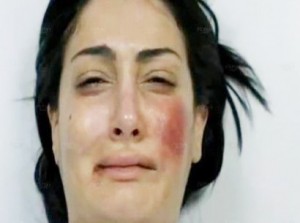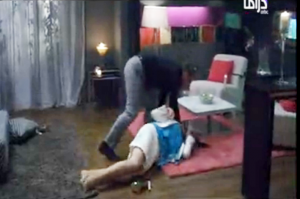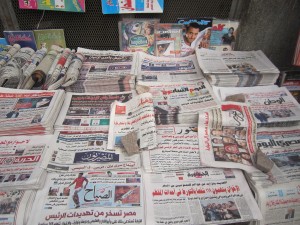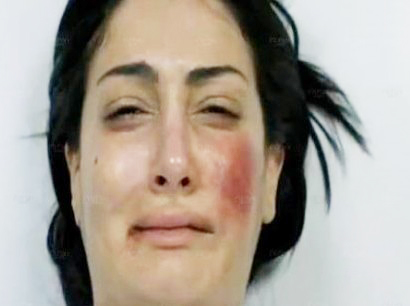
(Photo from MBC)
As she stood in her affluent apartment, his questions caught her off guard. He interrogated her about the man whose pictures she had, but he did not wait for an answer.
Infuriated as he was, he slapped her while screaming obscenities and shoved her down to the floor. He threatened to turn her khula case (a wife-initiated divorce under Islamic law) into a case of adultery.
In the next few minutes, the modern furniture she owned to show how well-off and successful she became was used to leave a mark of shame on her. He dragged her by her hair until she crashed into the coffee table.
This was not the end of the beating broadcasted on Maa Sabq el-Israr, one of the latest Egyptian soap operas that aired during Ramadan in 2012. The end came after two more minutes of constant swearing and beating that took place between Monir and his wife, Farida, two of the leading characters of the soap opera.
The scene was brutal. It was cited by news reports as the most “violent, but memorable scene” in all of last Ramadan’s soap operas. The scene acquired a notorious reputation for its graphic violence, invoked reviews and stirred discussion on TV talk shows.
A quick survey of these talk shows and reviews of this soap opera and others show that violence against women may have been a peripheral issue for criticism. The bigger portion was directed towards the censorship authority and the producers of these TV shows. Some critics condemned the lack of censorship for soap operas, how soap operas use pervasive language that offends viewers, how they ruin public manners and corrupt the “public taste”.
Mass media with its diverse outlets shape our perceptions and knowledge. According to several media studies, the most influential media outlets in Egypt are TV, print media and radio.
Unsurprisingly, TV plays a more significant role than the others due to the wide base of its audience, the diversity of its programmes and the use of visual imagery to communicate ideas, messages and stories.
With the excessive waves of violence against women hitting our streets (sexual violence directed at female protestors in Tahrir Square in addition to sexual harassment everywhere else) we are rightfully occupied by determining the politically charged reasons and deterioration of values and manners that result in this violence against and degradation of women.
Considering the importance of media shaping the community’s perspective, it is also crucial to revisit and evaluate the coverage of media outlets and how they contribute to promoting or condemning this phenomenon.

(Photo from MBC)
Dramatic representation of violence
While there have been a plethora of studies and research discussing violence against women in Egypt, those that focus solely on mass media coverage of violence are few and far between, in addition to being considerably outdated.
The most recent and comprehensive study concerned with the coverage of violence against women in Egyptian media is the 2009 study entitled “Violence against Women: Media Coverage of Violence against Women”. The study was conducted by the National Council for Women (NCW) Media Watch Unit and Cairo University Centre for Research on Women and Media. It examined content from the three main media outlets in Egypt over four years.
The study adopted the United Nations Declaration of Elimination of Violence against Women definition of violence. “Any act of gender-based violence [that] results in, or is likely to result in, physical, sexual, or psychological harm or suffering to women, including threats of such acts, coercion, or arbitrary deprivation of liberty, whether occurring in public or in private life… it encompasses, but not be limited to, physical, sexual and psychological violence occurring in the family…within the general community… perpetuated or condoned by the state,” reads the 1993 declaration.
After examining a sample of 64 television drama shows, 71.3% of these shows contained domestic violence against women (physical such as beating or psychological such as verbal insults), while 28.3% contained community violence (such as sexual harassment).
Rasha Abdallah is an associate professor and the former chair of the Department of Journalism and Mass Communication at the American University in Cairo. While admitting to not following drama series since the revolution started, she believes that the way media portrays women is problematic. “I am against all sorts of censorship, but if a content analysis were to be done and it proved that there is an excessive use of violence for no good reason or for the sake of sensationalising scenes, then this does not help women in any shape or form,” she says.
Abdallah emphasises that media affects notions and perceptions. She explains: “Whether it is through drama or advertising these depictions, this message [of beating women] when aired repeatedly over a prolonged period of time would be normalised.”
“We [people working in the media] have a huge distortion of the image of women and the media is contributing to it through drama, news reporting and even talk shows,” Abdallah continues. “The images you see of women are extremely stereotyped; she has to appear poor, a breadwinner, or a wife that is beaten up, humiliated or divorced.”
She adds: “The media would start setting the standards of societal relationships. It would start to be normal to see a woman beaten on TV; a Nubian mocked and so on. It would cease to shock society in any way… Eventually it becomes acceptable. Beating up a woman, humiliating her is becoming a measure of manhood.”
Research on media and violence concluded that there is a positive correlation between violence displayed through media sources and violence occurring in reality. The impact on children or youth transpires as a result of observational learning (modelling). The theory revealed that youngsters could acquire social behaviours through observation. When these behaviours are attractive and happen in a realistic context the propensity for them imitating these behaviours increases. And a similar process happens to adolescents and youths.
Soap operas of 2012 such as El-Baltagy (The Thug) and El-Zawga El-Rabaa (The Fourth Wife), those of 2011 like El-Mowaten X (Citizen X) and those that aired in 2010 like Kadeyet Safeya (Case of Safeya) all contained scenes of violence be it domestic or community violence. Even highly popular family sitcoms like El-Kabeer Awy involved verbal insults in a humorous context where the husband often called his wife “you, cow”.
Sherin Moody, an adjunct professor in the Department of Journalism and Mass Communication at the American University in Cairo comments about the selectivity of censorship policies.
She says: “The interesting thing about the process of filtration that happens to drama and movies is that they cut out the content that has most to do with sexuality, leaving in violence and pervasive language.”
“They think sex is more dangerous than violence while in fact they are very interrelated. Those people are blinded like horses with blinkers; they don’t realise that violence could escalate to rape, for example,” Moody adds.
Another astonishing finding in the NCW study was that women in drama were usually depicted as the source of family conflict and “responsible for family disintegration.” Thus, they deserve the violence directed at them. Even some who faced community violence were considered scandalous and a source of anxiety to their community.

(Photo from Al Hayat )
Facing violence in TV drama
Maggie Morgan is an independent filmmaker. She shot a short video of interviews conducted in the streets of Cairo where she randomly asked men and women from different educational and social backgrounds about their position on beating women.
“Almost all responses justified hitting women if they deserved it,” she says.
Morgan believes that TV soap operas are always in a hurry and under pressure to be ready for Ramadan (the biggest season of soap operas) so they become sensational and recycle clichés into the shows’ plotlines. However, no matter what the content was, she disagrees with censoring them. She says the solution is somewhere else.
“As a filmmaker I believe in total freedom of expression. However, it is also for civil society, critics, viewers, journalists and writers to examine our works and evaluate what’s harmful and what’s helpful. This dialogue is what’s important. I think drama is not meant to be didactic; it’s a form of creative expression. By being continuously critical about the content it presents, the media could clean itself internally,” she explains.
Abdallah thinks that the best to way to determine the detrimental trends in TV drama is to carry out scientific research on the content of the last ten years to be able to evaluate whether violence against women has been for sensational purposes or for dramatic context.
Abdallah adds: “There is no doubt that a classification or rating system would help, but it cannot happen overnight and it would face societal challenges. However, it would at least warn people and offer an alternative, and eventually people would learn it.”
Moody, on the other hand, believes that a serious media campaign concerning violence against women has to be carried to portray the negative consequences of violence. The campaign needs to involve all stakeholders, from government institutions to civil society and activist groups.

(Photo By: Sarah El Masry )
Coverage of violence in print media
While TV soap operas have ubiquitously depicted violence against women in a negative light by blaming the family’s disintegration or malfunctioning on women. Print media has been covering violence against women in a similar manner regarding women as source of provocation.
The NCW study included a sample of “672 issues of Egyptian daily newspapers and magazines (national, party, and private) and 96 issues of Egyptian weekly newspapers and magazines (national, party, and private)”.
The findings showed that 29.1% of the content within these issues reported or spoke of violence against women while the rest focused on other issues related to women. The print media coverage had a different focus of violence than that of dramatic representations on TV. Community violence was covered in 67% of the content while domestic violence was included in 33% of the sampled materials.
Analysis of the contents of different articles showed that there is caution in covering domestic violence. It is often viewed as a taboo topic leading newspapers and magazines to refrain from dedicating much content to it.
The coverage of community violence, though existed in length, “denigrated” the image of women when reporting on violent incidents. When community violence against women happened, much of the coverage rejected and condemned that type of violence whether it was on the streets or at the workplace.
However, the printed media seemed to be divided about discrimination against women regarding political participation. When violence against women occurred while demonstrating, some media outlets condemned it, while others did not.
This disparity in coverage is still valid, if not enhanced since the revolution. With sexual assaults and rape directed at women who are politically active and opposing the current regime, mantras of “blame-it-on-women” are chanted and circulated in print media as well as on TV. The justification is always that women, by marching in crowded areas, make themselves susceptible to violence.
Last week, when a Muslim Brotherhood member slapped Mervat Mousa, a woman who was drawing graffiti at the Muslim Brotherhood head quarters in Muqqatam, in the face, several articles blamed her for attacking the headquarters and provoking the man who slapped her. This was palpable in the way the Freedom and Justice Party members responded in newspapers.
The study showed how ownership of newspapers and magazines affected the coverage of violence incidents. Not surprisingly, state-owned newspapers were wider in their coverage due to their specialised pages on women, while private and party newspapers did not have such privilege. Nevertheless, the three types of print media (national, party, and private) did not offer solutions to issues of either domestic or community violence against women addressed in its discourse.
Only recently are we witnessing the print media starting to be self-critical of its approach to the issue of violence against women. This is a result of independent media outlets offering alternative coverage, casting light on and criticising coverage conducted by the mainstream media.
***
Several issues seem to be recurring while covering and depicting violence against women in mass media in Egypt. On TV and especially in dramatic representations, women are often viewed as the source conflict. This seems to be a way of justifying violence that transpires. And with the absence of a classification system in Egypt, there is no way to differentiate what topics are sensitive and only appropriate for certain ages.
This requires an examination to study the correlation between these representations and the increasing violence against women we are witnessing on our streets.
As for the print media, its coverage has an obvious disparity in covering different types of violence making community violence the priority focus for the coverage. This is problematic because it giving less attention is to the equally-disturbing problem of domestic violence, keeping these instances of abuse hidden behind the front doors of families’ homes and away from the public eye.
A few men and women on the streets of Cairo and Giza shared their opinions about the role the media should play when covering violence against women. Aya, 25, is a student. She says: “The media is confusing people. It does not have a clear vision about the message it is trying to get across to people. We [viewers] see them [people working in the media] using inappropriate language all the time and when youngsters watch this, they imitate and harass women and girls and everyone else.”
Ali, 61, is a janitor, and abhors violence against women. “The media should show people how to treat women properly, how to respect them and take care of them.”
Many other forms of televised media like TV programmes, talk shows, movies, sitcoms and radio drama and programmes should be examined to discover the features of their coverage and depictions of violence against women. This will help generate an open and fair dialogue about the issue of violence against women. Otherwise, viewers, readers and listeners are left with a mixed rhetoric.








